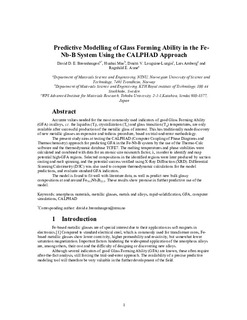| dc.contributor.author | Brennhaugen, David Dominikus Eide | |
| dc.contributor.author | Mao, Huahai | |
| dc.contributor.author | Louzguine-Luzgin, Dmitri V. | |
| dc.contributor.author | Arnberg, Lars | |
| dc.contributor.author | Aune, Ragnhild Elizabeth | |
| dc.date.accessioned | 2018-01-22T12:00:49Z | |
| dc.date.available | 2018-01-22T12:00:49Z | |
| dc.date.created | 2017-10-05T13:04:48Z | |
| dc.date.issued | 2017 | |
| dc.identifier.citation | Journal of Alloys and Compounds. 2017, 707 120-125. | nb_NO |
| dc.identifier.issn | 0925-8388 | |
| dc.identifier.uri | http://hdl.handle.net/11250/2478697 | |
| dc.description.abstract | Accurate values needed for the most commonly used indicators of good Glass Forming Ability (GFA) in alloys, i.e. the liquidus (Tl), crystallization (Tx) and glass transition (Tg) temperatures, are only available after successful production of the metallic glass of interest. This has traditionally made discovery of new metallic glasses an expensive and tedious procedure, based on trial-and-error methodology.
The present study aims at testing the CALPHAD (Computer Coupling of Phase Diagrams and Thermochemistry) approach for predicting GFA in the Fe-Nb-B system by the use of the Thermo-Calc software and the thermodynamic database TCFE7. The melting temperatures and phase stabilities were calculated and combined with data for an atomic size mismatch factor, λ, in order to identify and map potential high-GFA regions. Selected compositions in the identified regions were later produced by suction casting and melt spinning, and the potential success verified using X-Ray Diffraction (XRD). Differential Scanning Calorimetry (DSC) was also used to compare thermodynamic calculations for the model predictions, and evaluate standard GFA indicators.
The model is found to fit well with literature data, as well as predict new bulk glassy compositions at and around Fe70.5Nb7B22.5. These results show promise in further predictive use of the model. | nb_NO |
| dc.language.iso | eng | nb_NO |
| dc.publisher | Elsevier | nb_NO |
| dc.title | Predictive modeling of glass forming ability in the Fe-Nb-B system using the CALPHAD approach | nb_NO |
| dc.type | Journal article | nb_NO |
| dc.description.version | submittedVersion | nb_NO |
| dc.source.pagenumber | 120-125 | nb_NO |
| dc.source.volume | 707 | nb_NO |
| dc.source.journal | Journal of Alloys and Compounds | nb_NO |
| dc.identifier.doi | 10.1016/j.jallcom.2016.12.049 | |
| dc.identifier.cristin | 1502505 | |
| dc.description.localcode | This is a submitted manuscript of an article published by Elsevier Ltd in Journal of Alloys and Compounds, 6 December 2016. | nb_NO |
| cristin.unitcode | 194,66,35,0 | |
| cristin.unitname | Institutt for materialteknologi | |
| cristin.ispublished | true | |
| cristin.fulltext | preprint | |
| cristin.qualitycode | 1 | |
